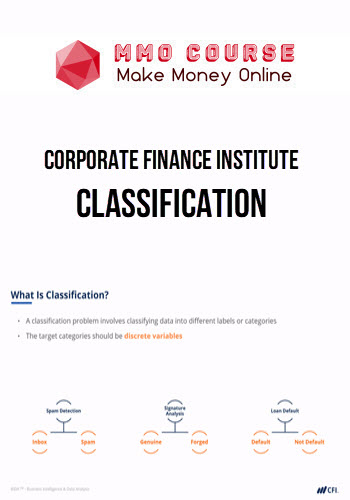Corporate Finance Institute – Classification: Fundamentals & Practical Applications
$997.00 $27.00
Total Sold: 1
Delivery: Instant Delivery
Description
Corporate Finance Institute – Classification: Fundamentals & Practical Applications
This course provides a comprehensive overview of classification problems, solutions, and interpretations along with walkthroughs of real-world scenarios.
Classification problems are one of the most common scenarios we face in data science. This course will help you understand and apply common algorithms to make predictions and drive decision-making in business.
Whether you’re an aspiring data scientist, studying analytics, or have a focus on business intelligence, this course will give you a comprehensive overview of problems, solutions, and interpretations.
From Logistic Regression to KNN and SVM models, you’ll learn how to implement techniques in Excel and Python and how to create loops to run models in parallel.
Since model evaluation is so important, we’ll dedicate a whole chapter to interpreting model outputs with evaluation metrics and the confusion matrix. With this, you’ll learn about false negatives, and false positives, and consider the impacts these may have on specific business scenarios.
Finally, we’ll give you a brief insight into more advanced classification techniques such as feature importance, SHAP values, and PDP plots.
Whether you’re an aspiring data scientist, studying analytics, or have a focus on business intelligence, this course will serve as your comprehensive introduction to this fascinating subject.
You’ll learn all the key terminology to allow you to talk data science with your teams, benign implementing analysis, and understand how data science can help your business.
What You’ll Learn In Classification: Fundamentals & Practical Applications
- Distinguish between classic techniques including their implicit assumptions and practical use-cases
- Perform simple logistic regression calculations in Excel & RegressIt
- Create basic models in Python using statsmodels and sklearn modules
- Evaluate and interpret the performance of model outputs and parameters
Sale Page: Corporate Finance Institute – Classification – Fundamentals & Practical Applications
Delivery Policy
When will I receive my course?
You will receive a link to download your course immediately or within 1 to 21 days. It depends on the product you buy, so please read the short description of the product carefully before making a purchase.
How is my course delivered?
We share courses through Google Drive, so once your order is complete, you'll receive an invitation to view the course in your email.
To avoid any delay in delivery, please provide a Google mail and enter your email address correctly in the Checkout Page.
In case you submit a wrong email address, please contact us to resend the course to the correct email.
How do I check status of my order?
Please log in to MMOCourse account then go to Order Page. You will find all your orders includes number, date, status and total price.
If the status is Processing: Your course is being uploaded. Please be patient and wait for us to complete your order. If your order has multiple courses and one of them has not been updated with the download link, the status of the order is also Processing.
If the status is Completed: Your course is ready for immediate download. Click "VIEW" to view details and download the course.
Where can I find my course?
Once your order is complete, a link to download the course will automatically be sent to your email.
You can also get the download link by logging into your mmocourse.hk account then going to Downloads Page.
Related products
Total sold: 1
Total sold: 4










